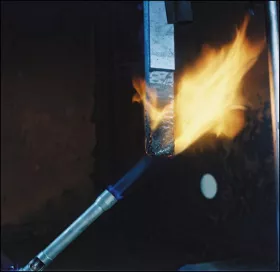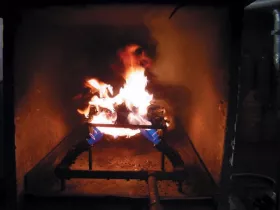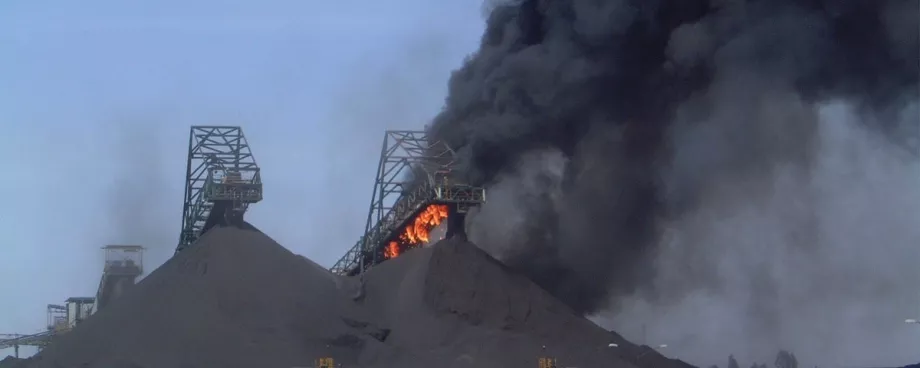EN/ISO 340 Testing

EN/ISO 340 tests involve exposing 6 individual samples of belt to a naked flame causing them to burn. The source of the flame is then removed and the combustion time (duration of flame) of the test piece is recorded. A current of air is then applied to the test piece for a specified time after the removal of the flame. The flame should not re-ignite.
The time it takes for the belt sample to self-extinguish is then measured. The duration of continued burning (visible flame) should be less than 15 seconds for each sample with a maximum cumulative duration of 45 seconds for each group of six tests. This factor is of paramount importance because it determines how fire can be effectively carried along a moving belt. The effects of fire being literally ‘conveyed’ to adjoining buildings can be seen in some of the photographs.
Even if a manufacturer states that their fire resistant belt has passed the ISO 340 test, the buyer should still exercise caution. A typical conveyor belt can easily travel more than 40 meters within the 15 seconds sufficient for a belt sample to pass the test but which would still allow the belt to carry flames over a potentially dangerous distance. For this reason our required time limit standard in Dunlop is no more than one second, ideally 0 seconds. Buyers of fire resistant belt are therefore recommended to ask to see copies of the test results and to check that the laboratory that has carried out the tests has EN ISO 17025 certification.
What Standard of Fire Resistance do I need?

One of the most difficult challenges for users of conveyor belts is establishing the correct level or standard of fire resistance is needed. For the vast majority of belts being used in the open air, Class 2A or 2B would be perfectly adequate. Class 2A demands that the belt is able to pass the ISO 340 test described earlier with the covers intact on the belt samples (K grade). Class 2B requires that the belt that can also pass the ISO 340 test with the top and bottom cover rubber removed (S grade). As mentioned earlier, the electrical conductivity of the belt also needs to fulfill the requirements of ISO 284.
If you are still unsure of the fire resistant grade of belting needed then it is best to carry out an internal risk assessment. If the expertise for this does not exist within your company then there are a number of external organizations (and almost certainly your insurers) that can perform this function for you.
For conveyors carrying materials which contain oil such as wood chips and biomass, rubber compounds that are resistant to fire, abrasion and oil are available. There are two types of oil resistance – mineral and vegetable. This is yet another important consideration when deciding on the correct type of fire resistant belt so buyers are recommended to be very specific when making requests for quotations from manufacturers and suppliers.
CEN Fire Test Standards
One of the most problematic aspects of fire testing rubber conveyor belts for industrial use above ground is that most of the test methods were established many years ago specifically for underground mining belts. Enormously complex and very costly testing has to be made by independent testing institutions. Because of environmental regulations, large-scale gallery fire tests now involve using a 12-meter long container filled with carbon to filter the smoke emissions before being released into the atmosphere.
In order to be awarded a safety standard certificate every belt type has to be independently tested. For some tests a minimum of 20 m of belt is needed. Such tests can easily cost up to EUR 20000 or more. For the manufacturers of solid woven underground mining belts and steelcord belting this is not a particularly big problem because there are a relatively small number of different belt types that have to be supplied in large quantities.
Although the test certificates are valid for several years, these large-scale tests present a huge and costly problem to manufacturers of rubber belting for above ground use because there is a much wider range of belt types. Such complex test methods have made it extremely difficult to develop improved levels of fire safety because if a belt sample fails the tests then the technicians have to go back to the drawing board to make further changes to the rubber compound and then embark on another round of expensive tests.
Apart from hindering development of fire resistant belting, it also means that it is very difficult to adequately test those belts that manufacturers claim reach specific levels of fire resistance. This is one of the reasons why there are so many end-users operating conveyors fitted with belts that provide totally inadequate levels of fire safety.
New CEN Fire Test Standards to be introduced
The problem has long been recognised by the CEN standards committee and over recent years they have been trying to find a solution. Following recent meetings attended by technical experts from all over Europe, the Committee European de Normalization will be introducing several positive changes in 2014.
Agreement has been reached on using and adapting tests already in existence for quality standards such as DIN and BS that will involve much smaller scale tests using much smaller equipment. This will mean that major manufacturers will be able to experiment and carry out testing in their own laboratories. Ironically, these new test methods will actually be even more demanding than the old, large-scale tests. Major insurance companies are already showing interest and are becoming involved in discussions. For them, and for all genuinely safety conscious organisations, this can only be very good news.
Don’t play with Fire
Although manufacturers and suppliers may be able to provide test certificates, in some cases that certificate may only relate to the belting that the manufacturer produced for test certification purposes. The actual belt delivered to site may well not be up to the required standard. For greater peace of mind we would suggest ordering an extra meter of belt and then have that piece of belt tested by an accredited testing authority or laboratory.
The price of not exercising caution simply cannot be calculated.
N.B.
This technical feature article relates to conveyor belts that are used above ground. For test methods and standards for conveyor belts used below ground please seek specific advice and guidance.
A Note from the Editor
For all statements in this article that refer – directly or indirectly – to the time of publication (for example “new”, “now”, “present”, but also expressions such as “patent pending”), please keep in mind that this article was originally published in 2014.
■



















